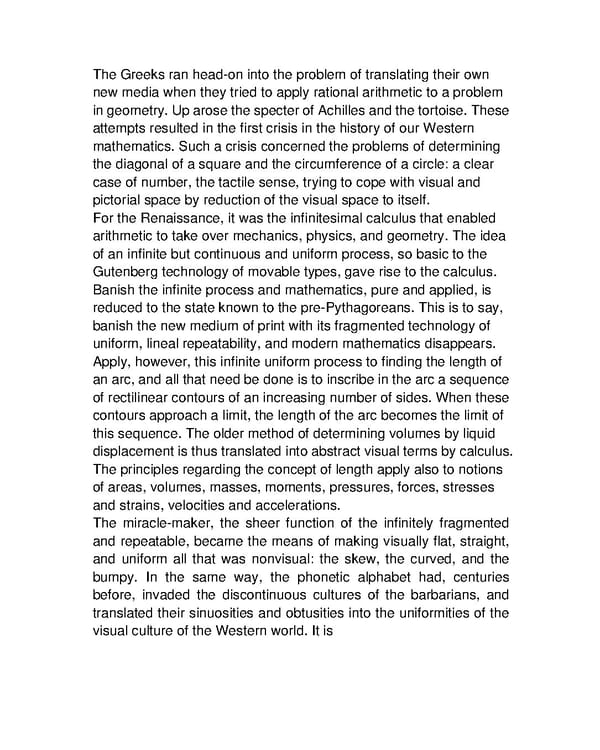The Greeks ran head-on into the problem of translating their own new media when they tried to apply rational arithmetic to a problem in geometry. Up arose the specter of Achilles and the tortoise. These attempts resulted in the first crisis in the history of our Western mathematics. Such a crisis concerned the problems of determining the diagonal of a square and the circumference of a circle: a clear case of number, the tactile sense, trying to cope with visual and pictorial space by reduction of the visual space to itself. For the Renaissance, it was the infinitesimal calculus that enabled arithmetic to take over mechanics, physics, and geometry. The idea of an infinite but continuous and uniform process, so basic to the Gutenberg technology of movable types, gave rise to the calculus. Banish the infinite process and mathematics, pure and applied, is reduced to the state known to the pre-Pythagoreans. This is to say, banish the new medium of print with its fragmented technology of uniform, lineal repeatability, and modern mathematics disappears. Apply, however, this infinite uniform process to finding the length of an arc, and all that need be done is to inscribe in the arc a sequence of rectilinear contours of an increasing number of sides. When these contours approach a limit, the length of the arc becomes the limit of this sequence. The older method of determining volumes by liquid displacement is thus translated into abstract visual terms by calculus. The principles regarding the concept of length apply also to notions of areas, volumes, masses, moments, pressures, forces, stresses and strains, velocities and accelerations. The miracle-maker, the sheer function of the infinitely fragmented and repeatable, became the means of making visually flat, straight, and uniform all that was nonvisual: the skew, the curved, and the bumpy. In the same way, the phonetic alphabet had, centuries before, invaded the discontinuous cultures of the barbarians, and translated their sinuosities and obtusities into the uniformities of the visual culture of the Western world. It is
 Understanding Media by Marshall McLuhan Page 131 Page 133
Understanding Media by Marshall McLuhan Page 131 Page 133